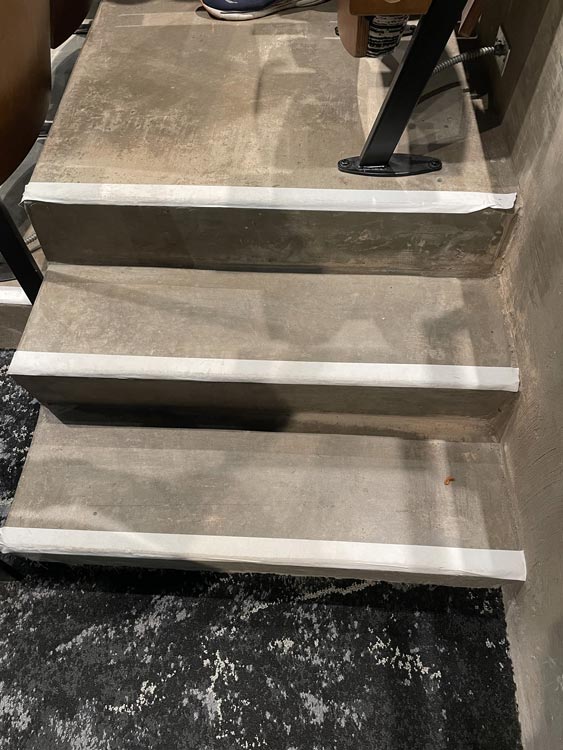Did You Know? – To (Avoid) Tripping the Light Fantastic
(Illustrative images are at the bottom of the article. Click an image to enlarge.)
Did you know there are specific rules in the building codes to ensure the audience can see steps within the aisles of places of assembly? The rules are found in both the International Building Code (IBC) and NFPA 101 – Life Safety Code, and are relatively similar. The good news is there are some options for the design team. The bad news is too many buildings aren’t getting this right.
Codes contain two options, using a rule and an exception. The requirements call for a contrasting marking stripe on each aisle stair, or a design ensuring the audience can easily see the edges of the stairs. It is important that one considers the low light conditions permitted in the aisles. In summary, the audience must be able to identify the location of stairs especially in descent.
The codes generally allow the lighting levels to be reduced to 0.2-foot candles in the aisles (IBC – 2024 1008.2.4 exception), well below the common one-foot candle rule. That’s relatively dim, but in a dark room considered bright enough.
Stair edge markings are installed to make the edges of stairs more visible, to improve foot placement when descending, and to reduce the risk of slips and falls. They are especially helpful in low light situations, on patterned treads and landings, and for patrons with visual impairments.
Stair edge marking materials must be placed on the edge of the stair tread with the material extending the full width of the stair. In general, dark colored treads should have light colored edge stripes, while, conversely, light colored treads should have dark colored edge stripes. It is important to focus primarily on contrast instead of color as there are no required colors or patterns on treads and landings. The edges of all steps, including the first and last steps, must be marked. As detailed in the IBC, stair edge marking stripes must be not less than 1” wide nor more than 2” wide.
When the design team wishes to avoid contrasting marking stripes, the exception provides an option. If the stairs are easily identified in all lighting conditions, then contrasting marking can be avoided. This likely means well placed aisle lighting designed to define the stairs, making it easy for the audience to identify. Lighting under the nosings illuminating the tread or landing below may be a good option, but it can also be distracting to performers when viewed from the stage or performance platform.
The codes in this area are somewhat subjective, adding to the complication. That does not relieve us of the responsibility for ensuring the audience can see the stairs so they can navigate them safely. It may make sense to err on the side of caution.
REFERENCE: 2024 International Building Code (IBC) 1030.14.2.3 Tread contrasting marking stripe.
A contrasting marking stripe shall be provided on each tread at the nosing or leading edge such that the location of each tread is readily apparent when viewed in descent.
Exception: The contrasting marking stripe is permitted to be omitted where tread surfaces are such that the location of each tread is readily apparent when viewed in descent.
By Robert Long, FASTC and Michael Parrella, ASTC
Disclaimer: Any views or opinions expressed in this article are solely those of the author and do not necessarily represent those of the American Society of Theatre Consultants. This article is for general information only and should not be substituted for specific advice from a Theatre Consultant, Code Consultant, or Design Professional, and may not be suitable for all situations nor in all locations.

















